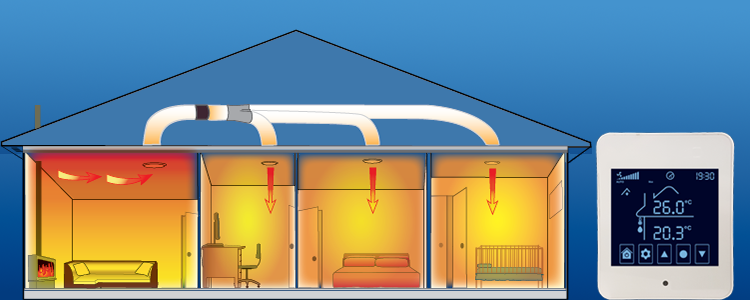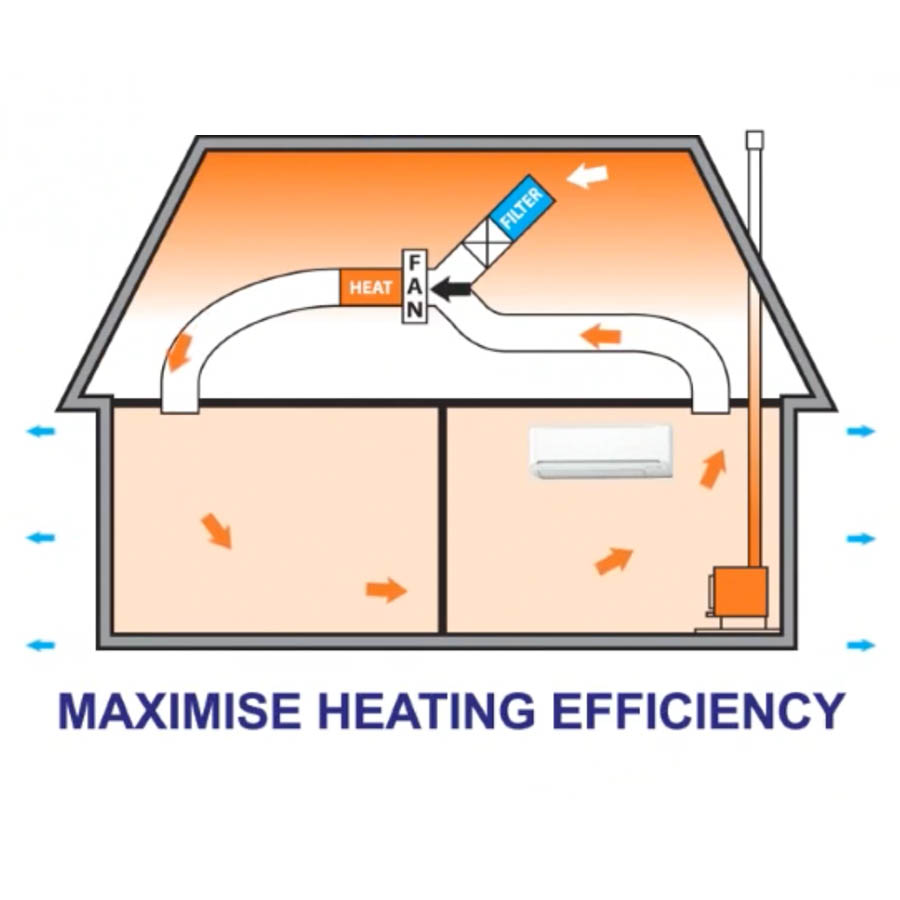DVS Heat Transfer Systems: The Future of Energy-Efficient Industrial Heating Solutions
Wiki Article
Exploring the Conveniences and Applications of Heat Transfer Systems in Modern Sector
Heat transfer systems play a vital role in modern sector. They include various devices such as convection, radiation, and conduction, each contributing to reliable thermal administration. Industries like manufacturing and aerospace advantage considerably from these systems. As developments proceed, the combination of cutting-edge materials and technologies assures to enhance power effectiveness. This advancement increases important concerns about the future ramifications for sustainability and functional expenses throughout multiple markets. What lies ahead in this recurring change?Understanding Heat Transfer Concepts
Heat transfer principles are essential to the procedure of various industrial systems. These concepts encompass the systems of convection, radiation, and transmission, each playing a vital duty in managing thermal energy. Recognizing transmission includes evaluating how Heat moves via solid materials, while convection concern Heat transfer in fluids, driven by fluid movement. Radiation, distinctive from the other 2, involves energy transfer with electro-magnetic waves. The efficiency of Heat transfer effects system efficiency, power intake, and overall productivity. Efficient thermal administration is essential in processes such as Heat, home heating, and air conditioning healing. By understanding these concepts, sectors can maximize their procedures, lower power prices, and boost tools long life, thereby contributing to a much more effective and sustainable industrial landscape.Key Types of Heat Transfer Solutions
While different markets use Heat transfer systems for diverse applications, several vital kinds stand out as a result of their details features and performances. One of the most typical types include transmission, convection, and radiation systems. Conduction systems transfer Heat via straight get in touch with between products, making them reliable in solid-state applications. Convection systems, on the other hand, utilize liquid motion to transfer Heat, appropriate for heating or cooling down fluids and gases. Radiation systems run without a tool, relying on electro-magnetic waves to move Heat, perfect for high-temperature atmospheres. Each type offers unique purposes, enabling industries to customize their Heat transfer solutions based upon operational demands, energy efficiency, and cost-effectiveness. Recognizing these systems is necessary for enhancing efficiency in different commercial setups.Industrial Applications of Heat Transfer Technologies
The application of Heat transfer modern technologies in market plays a vital duty in improving power effectiveness and maximizing processes. DVS Heat Transfer Systems. By applying sophisticated Heat exchange systems, business can substantially decrease their ecological impact while boosting overall efficiency. This integration not only cultivates sustainability but likewise straightens with contemporary governing and consumer demands for greener techniquesPower Effectiveness Improvements
As sectors increasingly prioritize sustainability, power performance improvements in Heat transfer modern technologies have ended up being crucial for lowering functional prices and environmental influence. Enhanced Heat exchangers, for example, utilize innovative products and designs to maximize thermal performance while lessening power consumption. Additionally, integrating variable rate drives in pumping systems enables for much better control of fluid circulation, resulting in considerable energy financial savings. The implementation of smart sensors and automation offers real-time tracking, allowing modifications that enhance energy use. Additionally, waste Heat recuperation systems record excess thermal power, transforming it into functional power. These improvements not just enhance energy efficiency but also add to a more lasting commercial landscape by lowering greenhouse gas discharges and supporting compliance with environmental policies.Refine Optimization Techniques
Refine optimization strategies are important in boosting the effectiveness and efficiency of Heat transfer modern technologies in commercial applications. These methods include refining processes to make the most of Heat transfer efficiency while lessening energy intake and functional expenses. Methods such as computational liquid dynamics (CFD) modeling allow engineers to examine and simulate Heat transfer situations, identifying locations for enhancement. Additionally, real-time surveillance systems can supply important information on temperature level gradients and circulation rates, making it possible for modifications that optimize efficiency. In addition, executing sophisticated control techniques, such as anticipating analytics, can improve system responsiveness to varying functional demands. By applying these optimization methods, industries can accomplish better thermal performance, minimized downtime, and enhanced product high quality, ultimately resulting in increased competitiveness in the industry.
Environmental Effect Decrease
While industrial Heat transfer technologies are crucial for operational effectiveness, their application additionally presents possibilities for substantial environmental effect decrease. By boosting energy effectiveness, these systems lessen gas consumption, causing reduced greenhouse gas exhausts. As an example, progressed Heat exchangers can recoup waste Heat, redirecting it to preheat incoming fluids, consequently reducing energy needs. On top of that, the assimilation of Heat transfer technologies in renewable resource systems, such as solar thermal and geothermal applications, supports the shift to sustainable methods. Industries that use these technologies also benefit from reduced operational costs and enhanced regulatory compliance. Overall, the tactical implementation of Heat transfer systems not only bolsters productivity but additionally cultivates an extra lasting commercial landscape, adding to worldwide environmental goals.Benefits of Reliable Heat Transfer Solutions
Effective Heat transfer systems provide significant advantages in modern-day market, mostly with enhanced energy performance and price reduction. By optimizing thermal management, these systems decrease power waste, causing reduced functional expenses (DVS Heat Transfer Systems). Companies can accomplish greater sustainability and improved success.
Energy Effectiveness Improvements
As sectors increasingly prioritize sustainability and cost-effectiveness, energy effectiveness renovations in Heat transfer systems have actually arised as a vital focus. Improved effectiveness in these systems brings about decreased energy consumption, making it possible for centers to run even more sustainably. By maximizing Heat transfer methods, industries can minimize waste Heat and achieve better thermal management, significantly lowering their environmental impact. Advances in technologies such as Heat exchangers and insulation products add to enhanced performance and reliability. Furthermore, implementing energy-efficient Heat transfer options not just supports compliance with regulatory standards yet additionally promotes a culture of innovation within companies. Eventually, these improvements are crucial in straightening industrial procedures with worldwide energy preservation goals, paving the means for a much DVS Heat Transfer Systems more lasting future in production and processing fields.Expense Reduction Opportunities
By enhancing Heat transfer systems, sectors can expose substantial expense reduction possibilities that enhance their profits. Efficient Heat transfer reduces power consumption, bring about lower energy expenses and minimizing operational expenditures. Furthermore, boosted system performance lowers the need for repair and maintenance, additionally saving prices in time. Boosted Heat transfer can also prolong tools lifespan, enabling companies to postpone capital investment on substitutes. Waste Heat healing systems can change excess Heat right into usable energy, better driving down costs. These systems not only enhance procedures yet also add to sustainability campaigns, placing companies favorably in a progressively eco-conscious market. On the whole, the financial benefits of effective Heat transfer systems are significant and essential for affordable benefit.Innovations in Heat Transfer Solutions
Exactly how can contemporary market improve its procedures via cutting-edge Heat transfer remedies? By embracing advanced materials and modern technologies, markets can greatly improve thermal efficiency and performance. Innovations such as nanofluids, which enhance Heat transfer capabilities past conventional fluids, and phase adjustment products that save and launch thermal power, are getting traction. Furthermore, the integration of smart sensing units and IoT gadgets allows for real-time tracking and optimization of Heat transfer processes, decreasing waste and improving system responsiveness. Additive manufacturing techniques make it possible for the production of more complex Heat exchangers that maximize surface location while lessening material usage. Collectively, these innovations drive functional efficiency and produce affordable benefits in numerous markets, consisting of aerospace, power, and manufacturing.The Duty of Heat Transfer in Sustainability Efforts
While the promote sustainability continues to improve markets, the duty of Heat transfer innovations becomes significantly necessary in achieving ecological goals. Reliable Heat transfer systems assist in energy effectiveness by optimizing thermal monitoring in different procedures, significantly lowering energy intake and greenhouse gas emissions. As an example, advanced Heat exchangers are made use of in industrial applications to recover waste Heat, therefore decreasing energy waste. In addition, technologies such as phase modification products enhance thermal storage, adding to renewable resource combination. The adoption of sustainable fluids in Heat transfer systems can minimize ecological influence. By prioritizing efficient Heat transfer, markets not only enhance functional efficiency yet additionally align with global sustainability efforts, promoting a cleaner, a lot more lasting future.Regularly Asked Questions
How Do Heat Transfer Systems Influence Energy Expenses in Manufacturing?
Heat transfer systems considerably influence energy costs in manufacturing by enhancing effectiveness, decreasing waste, and maximizing thermal administration. These enhancements cause reduce functional costs, eventually benefiting overall productivity and success in industrial procedures.What Upkeep Is Needed for Heat Transfer Solutions?
Maintenance for Heat transfer systems consists of normal assessments, cleansing of elements, checking fluid levels and conditions, changing used components, and guaranteeing proper insulation. These actions boost performance, prolong lifespan, and prevent pricey failures in procedure.Exist Security Interest In Heat Transfer Equipments?
Safety worry about Heat transfer systems include prospective leaks, stress accumulation, and thermal threats. Appropriate layout, routine upkeep, and adherence to security protocols are necessary to reduce these threats and guarantee secure operation in commercial environments.
Just How Can I Pick the Right Heat Transfer System for My Service?
Picking the best Heat transfer system involves examining factors such as effectiveness, application needs, budget restrictions, and safety and security requirements. A detailed analysis of these aspects will certainly help ensure excellent performance and dependability in service procedures.What Prevail Failures in Heat Transfer Equipments and Their Causes?

Comprehending conduction entails evaluating just how Heat relocates with strong materials, while convection pertains to Heat transfer in liquids, driven by fluid movement. By optimizing Heat transfer methods, markets can minimize waste Heat and attain much better thermal management, considerably lowering their environmental influence. Waste Heat healing systems can change excess Heat right into usable energy, better driving down expenses. Progressed Heat exchangers are used in commercial applications to reclaim waste Heat, therefore reducing power waste. Common failures in Heat transfer systems include leaks, rust, and inefficient Heat exchange.
Report this wiki page